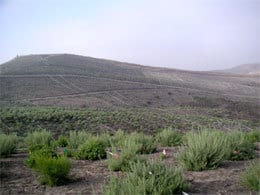Case Study: Whispering Hills Revegetation Project
- Posted in: About Tree of Life, California Native Plants
- Tags Conservation, Ecosystems
| During the past year Tree of Life Nursery has been supplying plants to, and following the progress of a very successful revegetation project in the Whispering Hills development. This 75 acre site straddles a ridge on the edge of San Juan Capistrano, just a few miles down the Ortega Highway from our nursery.
One of the mandates in the development agreement for the Whispering Hills custom residential subdivision was to create Coastal Sage Scrub habitat on the lower slopes of the property. Historically rangeland, the site was completely dominated by artichoke thistle, Cynara cardunculus—a pernicious Mediterranean weed found in many warm climates throughout the world. Left unchecked, this introduced species produces a formidable monoculture that mutes the traditionally diverse native plant palette, in turn adversely affecting wildlife by eliminating forage and nesting sites. In many cases the removal of such infestation is not economically feasible due to the labor-intensive, prolonged process required to eliminate the thistle and establish desirable replacement species. In this instance, the cost was mitigated by the profit from eventual sales of adjacent homes. Even with financial support from the master developer a project of this scale can be prohibitively expensive without proper management. To date, Whispering Hills has been successful—not only in realizing the goal of reestablishing habitat, but from a business standpoint as well. Through careful planning and execution, mitigation deadlines will be met without penalty to the master developer, and the improved open space is an amenity that will increase the value of the entire residential project. Project manager Jeff Johnson of Park West kept the job on track by using liner size nursery stock. With unpaved roads and steep terrain, this choice not only saved money, but reduced labor at installation as well. These savings helped offset the cost of the labor-intensive site clearing and post-installation weed control—two steps that contributed to the excellent establishment rate of the young plants. By late summer the site was virtually weed-free with a healthy 2-3 foot high cover of Baccharis, Artemisia, Eriogonum and Encelia. In addition to good management, the success of this project was influenced by several favorable circumstances. Because little grading or discing was required the site was relatively undisturbed, reducing erosion and preventing buried weed seed from germinating. The small liner stock planted in this intact site averted problems common to disturbed sites: settling and subsequent death due to crown rot. Located four miles from the coast, marine influence and cool summer nights helped the rapidly-growing, overhead-irrigated plants survive their first summer with losses at less than 5%. The impressive progress of the Whispering Hills revegetation project demonstrates that the cost and effort is worthwhile. In restoring wildlife habitat and satisfying mitigation obligations, the developer has also created a valuable amenity for prospective buyers, with hiking and equestrian trails that pass through the restoration area providing neighborhood and community benefits for decades to come. |

|


